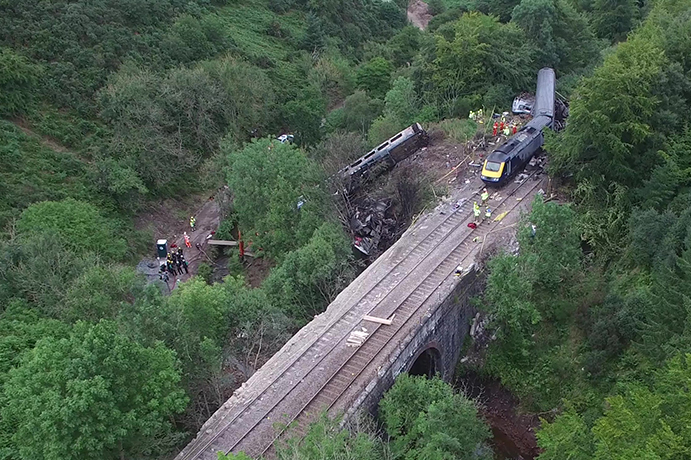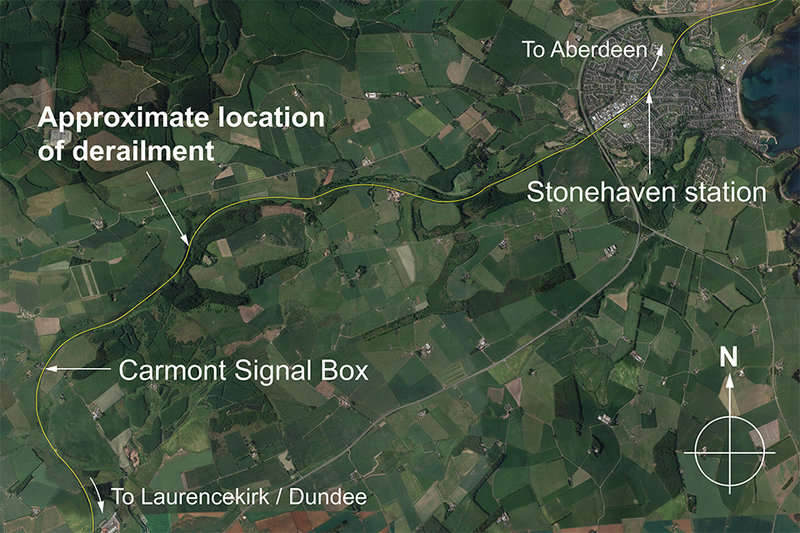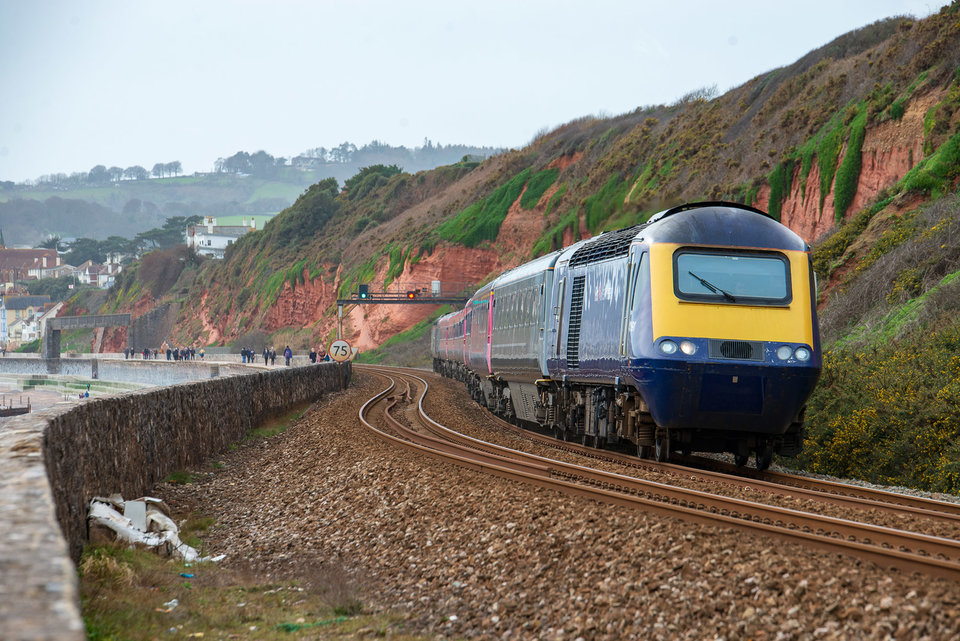Safety
Stonehaven rail crash: key lessons to learn
A recent train derailment in Scotland that proved fatal for three people has highlighted the threat posed by increasingly extreme weather patterns to rail safety. Adele Berti asks: what lessons can be learned for the future?
It
has been less than six months since Future Rail last covered climate change and the impact extreme weather conditions can have on UK railways. In the summer, a new season of heavy rains and floods headed to Britain, causing a train crash that claimed three deaths.
According to national infrastructure manager Network Rail, a train driver, a conductor and a passenger died in a derailment in August after “the force of thousands of gallons of water flowing from [a] breached canal bank” damaged tracks and eventually knocked a train off of them near Stonehaven in rural Scotland.

Aerial view of the derailment. Image: UK Government
These deaths were the first fatalities seen on a train in Britain in over 13 years, though the crash was one of many to be reportedly caused and aggravated by climate change, rising temperatures and intense rainfall.
Speaking in the aftermath of the tragedy, UK Prime Minister Boris Johnson said lessons will need to be learnt from the accident to ensure British railways are safer and more resilient in the face of harsher weather. We’ve rounded up key lessons from the incident below.
Climate change cannot be underestimated
The magnitude of climate change is hardly quantifiable and the UK experiences this first-hand several times a year. Its impact was particularly severe this time around, not just because of the lives it claimed but also in terms of the damage it caused to Scottish railways.
Head of the UK’s Rail Accident Investigation Branch Simon French recently described the crash as “amongst the worst” he had ever seen in his 16-year-long career, though admitted it was still too early to draw definitive conclusions.
The extent of the flooding and the scale of the damage is something I have never witnessed before
A press release from Network Rail echoed this sentiment as it estimated it will take at least two months to carry out repairs. “It is remarkable to see the destructive power of the flowing water and the extent of the flooding and the scale of the damage is something I have never witnessed before on the railway,” Network Rail route delivery director Kevin McClelland said in a press release.
Having been built over 150 years ago, the British rail network must now brace itself for drastic changes, with the latest UK climate projections (UKCP18) forecasting that sea levels could rise between 3cm and 37cm in different parts in the UK while heavy rainfall could increase by 10% by 2050.
The network is currently unable to cope
This is the verdict of a recent report by the Office for Rail and Road (ORR). Having been published shortly before the Stonehaven accident, the study found that more needs to be done to protect the network and its passengers.
“Although safety across Britain’s railways has improved over the last 12 months, exceptional seasonal weather conditions continue to adversely affect safety performance,” the regulator wrote in a press release. “The number of earthwork failures and train-striking objects – such as trees – increased almost fourfold compared to last year.”
The number of earthwork failures and train-striking objects increased almost fourfold compared to last year
The report also mentioned that Network Rail’s recent plans to increase resilience throughout the country were not sufficient to cope with the frequency and severity of extreme weather. As a result, the ORR issued two improvement notices for the infrastructure manager to urgently put in place in order to improve track worker safety, as well as access, planning and use of technology.
Yet this doesn’t mean that Network Rail is not acting. In response to the crash, the company launched two separate task forces to investigate the events leading up to it and ways to protect passengers and railways in the future.
Earlier in September, it also published a preliminary report on the accident, which looked into the current control and management of thousands of miles of earthworks and set out a series of short and long-term actions. These include spending £1.3bn to make the network more resilient in the face of climate change by 2024 - though only some £149m is expected to be spent on Scottish railways.

A Google Earth image showing key locations to the crash. Image: UK Government
Prevention and monitoring technologies are a priority
Remote monitoring technologies are gaining traction in the industry as one of the most efficient ways to prevent damage caused by extreme weather. “Network Rail must focus on improving identification of imminent failure by means of remote monitoring and on refining the measures it has to respond to forecasts of extreme conditions,” the ORR wrote in its study.
This is something that Network Rail seems committed to doing, as it wrote in its preliminary study.
“Key findings also suggest that industry rules for reporting and responding to adverse rainfall will be improved and strengthened, helping signallers better manage services during bad weather,” a press release added. “Other plans include discussions with meteorologists to understand how real-time information can be better used to inform train operations about unpredictable extreme weather.”
Industry rules for reporting and responding to adverse rainfall will be improved and strengthened
The company is also already developing cutting-edge techniques for monitoring and managing areas at risk. Last year, Network Rail told Future Rail about its continued collaboration with the Met Office, marine, coastal and geotechnical engineers, and railway consultants to come up with the most up-to-date resilience plans.
The UK and many other countries are also studying ways to use new technologies, such as drones, sensors, artificial intelligence, optical and radar satellites, and remote monitoring equipment to improve weather forecasts, as well as identify areas of intervention and potential faults in rail systems and tracks.
British railways need to be more resilient
New technologies are expected to improve rail operations and monitoring in the years to come, but action is also needed in the immediate future. In practical terms, this means making adjustments to the existing infrastructure and ensuring it is more resilient against floods, storms and other high-risk events.
One of Network Rail’s two task forces is currently looking into the matter. For over a month, the Earthworks Management task force has been investigating several factors, including the availability of sources and skills to manage assets and the effectiveness of Network Rail’s current approaches to managing earthworks and cuttings.
We are improving and accelerating our resilience work
Moving forward, stronger measures and more substantial renovation works may be required to protect the British rail network. One such example is the Dawlish sea wall, which is currently being built to protect local tracks from the threat of rising sea levels.
“Our railway is one of the safest in Europe and tragic accidents are incredibly rare, but something went wrong on 12 August near Stonehaven and it is a stark reminder that we must never take safety for granted,” Network Rail chief executive Andrew Haines recently said. “We are improving and accelerating our resilience work and will do everything we can to minimise the impact of weather on the safety and reliability of the railway as our climate continues to change.”
Outside of the UK, several countries have also been looking for ways to protect their networks from rainfall and floods. In Japan, for example, parts of a holding yard for Shinkansen trains are to be lifted by some 10m to protect it from floods. Meanwhile, in Europe, Rail Baltica is also preparing a set of measures to protect tracks from waterways.

The Dawlish Sea wall in Devon, UK. Image: Blake Cracknell | Shutterstock.com